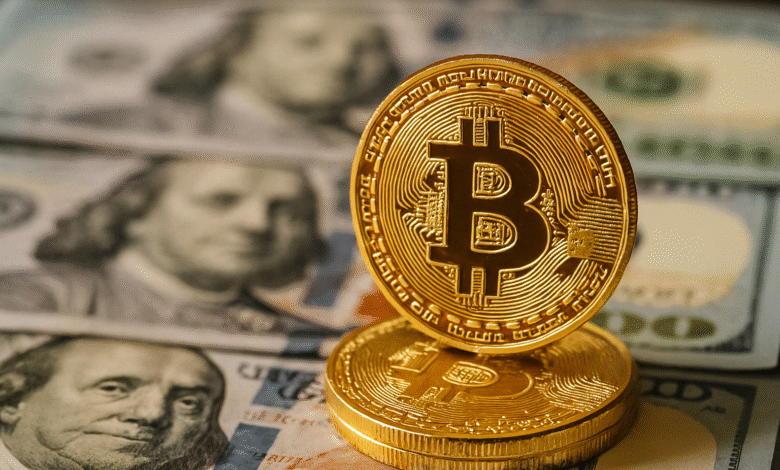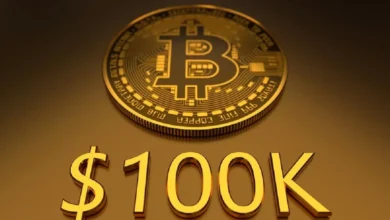Bitcoin Price Target JPMorgan Says $170K in 12 Months
JPMorgan forecasts Bitcoin could reach $170K within a year. Explore the model, catalysts, risks, and what it means for BTC investors.

The Bitcoin price narrative has taken a dramatic turn as JPMorgan’s global markets team argues that BTC could climb toward $170,000 within the next six to twelve months. Far from a speculative soundbite, the call rests on a structured valuation framework that compares Bitcoin to gold on a volatility-adjusted basis and gauges how much risk capital BTC attracts relative to the yellow metal. Following a sharp October shakeout that saw aggressive deleveraging in crypto derivatives and a dip below the six-figure mark, JPMorgan contends Bitcoin now screens undervalued versus gold and has “significant upside” over the coming year.
In their latest work, the bank’s strategists—frequently led by Nikolaos Panigirtzoglou—outline a fair-value band implying $170K as a reasonable target if Bitcoin continues converging toward gold’s private investment base after adjusting for BTC’s higher volatility. Bitcoin Price Target. Multiple outlets have echoed the figure, with reporting that frames the upside around 67% from early-November levels and a 6–12 month window to close the gap.
This piece unpacks the forecast, the model behind it, what could push the Bitcoin price higher, and the key risks that could derail the path. It also offers practical context for readers weighing allocation decisions in an evolving market that increasingly treats Bitcoin as digital gold.
Why JPMorgan Sees $170K: The Core Thesis
JPMorgan’s $170K argument stems from a comparative lens: if Bitcoin continues to capture a share of gold’s private investment base, then a volatility-adjusted parity framework points to a higher Bitcoin price. The methodology scales exposures by realized or implied volatility so that a dollar in BTC “risk capital” is comparable to a dollar in gold. On this basis, JPMorgan argues that Bitcoin is now trading well below its fair value relative to gold after a forceful October washout in perpetual futures and ETF outflows—conditions the bank believes have largely de-risked the market.
Independent coverage of the note underscores the same conclusion: BTC’s fair value sits near $170,000 today under the bank’s model, up from earlier estimates near $102,000, with the delta explained by shifts in volatility and the scaling of crypto’s risk capital against gold. The view is that BTC can reasonably align with roughly two-thirds of gold’s private investment base over the next year, hence the target.
How the Volatility-Adjusted Gold Model Works
A persistent critique of crypto price targets is that they often lean on opaque assumptions. JPMorgan’s approach tries to be explicit: measure the Bitcoin-to-gold allocation after normalizing for volatility, then assess how far Bitcoin sits from parity (or a fraction of it) with gold’s private investment holdings. When the volatility ratio narrows or when capital rotates from gold to BTC, the model’s fair value for Bitcoin price lifts; when volatility widens or flows reverse, it falls. Recent coverage cites a volatility ratio near the 1.8–2.0 range, implying BTC requires more risk budget than gold but not egregiously so—and at current inputs, the implied under-valuation relative to gold is about $68,000, which maps to the headline $170K number.
It’s a macro-quant lens rather than a mining-cost or on-chain metrics valuation. That matters for investors who have historically anchored to hash rate, miner capitulation, and realized price models. The gold-parity approach ties BTC to a well-known store-of-value benchmark and a global pool of savings, which helps explain why the forecast resonates beyond the crypto-native crowd.
What Changed After the October Shakeout

The bank’s call lands just after a bruising month in which Bitcoin corrected more than 20% from its early-October all-time high to sub-$100K prints before stabilizing. JPMorgan attributes the drop to heavy perpetual futures liquidations and negative headlines in decentralized finance, both of which amplified risk reduction across the crypto market. Crucially, the deleveraging reset positioning metrics—like open interest as a share of market cap—closer to long-run averages, a backdrop the bank reads as constructive. With leverage washed out, any renewed demand can lift the Bitcoin price more cleanly.
Coverage also notes that following the washout, Bitcoin now looks cheaper versus gold on a volatility-adjusted basis than it did earlier in the year, flipping a prior JPMorgan stance that had sometimes flagged overvaluation when BTC was running hot. That pivot—undervalued to fair value at $170K—is the heart of the new upside case.
Catalysts That Could Push Bitcoin Toward $170K
The Role of Spot Bitcoin ETFs and Institutional Flows
A defining feature of this cycle is the presence of spot Bitcoin ETFs that lower operational frictions for institutions and advisors. Even when weekly flows turn choppy, the existence of these vehicles broadens the addressable base for BTC allocation and can create a steady bid when risk appetite improves. In the gold-parity framework, every incremental dollar that shifts from gold or cash into volatility-adjusted BTC exposure helps close the valuation gap and nudge the Bitcoin price toward the $170K fair value. Recent coverage of JPMorgan’s note explicitly ties the opportunity to how risk capital reallocates between gold and Bitcoin over the coming quarters.
Macro Cross-Currents: Rates, Liquidity, and the Dollar
Macro still matters. If the Federal Reserve transitions from holding to easing as inflation cools, easier financial conditions can support liquidity across risk assets. Historically, Bitcoin’s biggest momentum phases aligned with improving liquidity and benign real yields. Conversely, a stronger dollar and higher real yields can suppress flows into volatile assets. JPMorgan’s model doesn’t require perfect macro, but the glidepath to $170K gets smoother when global liquidity isn’t tightening and when hedging demand for digital gold is elevated by fiscal and debt dynamics—a theme macro investors continue to monitor.
The Halving’s Second-Order Effects
The halving cycle cuts net issuance in half, gradually reducing sell-side pressure from miners. While JPMorgan has previously cautioned that halving effects can be priced in, the post-halving periods often see an improving supply-demand balance as hash-price stabilizes and miners optimize operations. Over a 6–12 month horizon, tighter net supply can magnify the impact of renewed inflows via ETFs or direct purchases, mechanically supporting the Bitcoin price as it converges toward the volatility-adjusted fair-value band.
Narrative Momentum and the Digital-Gold Thesis
The market’s story matters as much as the math. As mainstream outlets reiterate JPMorgan’s $170K view, and as JPMorgan analysts discuss relative value versus gold, the digital gold narrative gains more airtime with allocators who might have sat out previous cycles. This narrative cohesion—Bitcoin as a macro hedge and store of value—creates a reflexive loop where rising adoption bolsters the thesis that justifies further adoption. Recent reporting explicitly frames the call in those terms: match a meaningful slice of gold’s private investment base on a volatility-adjusted basis and the Bitcoin price has room to run.
Key Risks That Could Derail the Path to $170K

Policy Shocks and Regulatory Fragmentation
While the baseline outlook is constructive, policy risk remains. Adverse regulation, fragmented global standards, or enforcement actions targeting exchanges and stablecoins can deter institutional flows and widen BTC’s volatility relative to gold—weakening the parity argument. If headline risk pushes investors back into gold, the rotation narrative stalls, and the Bitcoin price may lag the $170K trajectory.
Liquidity Drains and Macro Surprises
Liquidity is the lifeblood of crypto markets. A sudden tightening in global financial conditions—via higher real rates, QT acceleration, or dollar spikes—can compress risk budgets. In JPMorgan’s model, a higher volatility ratio or shrinking risk capital would mechanically lower fair value and push the Bitcoin price farther from $170K.
Derivatives-Driven Drawdowns
Even after October’s cleansing, perps and options can still produce sharp liquidations during stress events. Derivatives are a double-edged sword: they enable efficient exposure, but when positioning gets crowded, the unwind transmits quickly into spot. JPMorgan’s constructive read relies on leverage metrics mean-reverting; if they re-inflate too quickly, a repeat drawdown could interrupt the climb toward the target.
Security Incidents and Operational Shocks
High-profile exploits in DeFi or custodial failures can chill risk appetite. October’s backdrop included a widely covered theft from a DeFi protocol, feeding a broader flight-to-quality impulse. The more institutional investors demand best-in-class custody, insurance, and compliance, the more resilient flows become. But a spate of incidents would challenge the fair-value convergence story.
How to Interpret $170K Without Over-Optimizing
A Fair-Value Anchor, Not a Guarantee
JPMorgan’s $170K is a fair-value estimate, not a hard guarantee. Think of it as an anchor that orients expectations around how BTC might price if it keeps absorbing a defined share of gold’s private investment capital after scaling for volatility. As inputs shift—volatility, flows, macro variables—the anchor moves. Treat it as a scenario with probabilities, not a promise.
Time Horizon and Path Dependence
The bank’s coverage highlights a 6–12 month window, which is wide enough to capture real-world uncertainty but specific enough to be actionable. The Bitcoin price could overshoot or undershoot mid-course, particularly around CPI prints, Fed meetings, geopolitics, or ETF flow bursts. Being mentally prepared for uneven progress helps investors avoid FOMO at local highs or capitulation at local lows.
Role Sizing and Volatility Budgets
A quiet insight from the model is that role sizing matters. If you budget risk capital on a volatility-scaled basis—allocating to BTC with an eye on realized vol versus gold—you’re essentially living the same math JPMorgan uses. That can mean smaller nominal position sizes in BTC still deliver comparable portfolio impact to larger gold allocations. It’s a lens for advisors balancing digital gold with traditional hedges.
What Could Take Bitcoin Beyond $170K?
A Deeper Rotation From Gold
If private investors accelerate rotation from gold into BTC, the volatility-adjusted parity mark could extend beyond two-thirds of gold’s base, pushing the Bitcoin price above $170K. The presence of scalable spot ETFs makes that rotation more feasible than in prior cycles.
Structural Demand From Sovereigns and Corporates
A steady drumbeat of treasury allocations from corporates, or a gradual embrace by sovereigns seeking reserve diversification, could create a persistent bid not fully captured by tactical ETF flows. While still speculative, such flows would raise the ceiling on the parity model by expanding the very pool of risk capital dedicated to digital assets.
A Friendlier Macro Backdrop
Sustained disinflation, easier policy, and improving global risk sentiment would amplify demand for BTC as both a store of value and a high-beta macro asset. In that regime, realized volatility may compress relative to gold, further enhancing the volatility-adjusted appeal and mechanically lifting fair value.
What Would Invalidate the Thesis?
If real yields rise meaningfully, the dollar strengthens, and global liquidity tightens at the same time that ETF inflows stagnate or reverse, the argument for rapid convergence to $170K weakens. A series of security failures or regulatory shocks that materially elevates BTC volatility relative to gold would also pull down the model’s fair value. Investors should monitor the volatility ratio, ETF flow data, and open interest as real-time barometers for whether the thesis is on track.
Context Within the Current Cycle
The present cycle differs from earlier ones thanks to institutional rails and a more mature market infrastructure. Nonetheless, some elements rhyme: post-halving supply dynamics, long lead-times for the market to digest regime changes, and punctuated bouts of deleveraging. Analysts—including at JPMorgan—have not always been uniformly bullish around halvings, but the fresh lens of gold parity gives this cycle a macro anchor investors can debate and update as data arrives.
See More: Bitcoin Mining Stock Canaan Sinks 16% What Happened
Investor Takeaways
Treat $170K as a data-driven waypoint backed by a transparent relative-value model. Watch the inputs: the BTC-to-gold volatility ratio, ETF flows, derivatives leverage, and macro liquidity. Respect the risks: regulatory shifts, security incidents, and derivatives-driven drawdowns can all inject setbacks. But if the thesis of digital gold continues to embed itself in portfolios—and if BTC keeps winning scaled allocations—then the path sketched by JPMorgan becomes more plausible with time. Recent press coverage is aligned on this point: there is 67% upside on the table if fair value converges within the next year.
Conclusion
JPMorgan’s Bitcoin price call for $170,000 in the next 6–12 months is not just a headline—it’s a structured case that compares BTC to gold on a volatility-adjusted basis and finds the crypto asset undervalued after a market reset. The model grounds the narrative in flows and risk budgets rather than wishful thinking, and the current market architecture—from spot Bitcoin ETFs to better custody—means the mechanisms for convergence are in place.
None of this makes the journey linear, and the same volatility that creates upside potential can also deliver unnerving detours. Still, for investors thinking in terms of fair-value anchors and incremental rotation from gold, $170K is an intelligible destination rather than a moonshot. The next year will test whether BTC can keep absorbing risk capital at the pace JPMorgan envisions—and whether the digital gold story continues to win converts.
FAQs
Q: What exactly does “volatility-adjusted parity with gold” mean?
It means JPMorgan scales Bitcoin and gold allocations by their respective volatility so that one unit of risk capital in BTC can be compared to one unit in gold. If BTC’s allocation, on that scaled basis, reaches a targeted share of gold’s private investment base, the model implies a Bitcoin price near $170K today.
Q: Why did JPMorgan’s tone shift after October?
Because the market experienced a substantial deleveraging in perpetual futures and risk reduction across crypto, which pulled positioning back toward historical norms. After that reset, JPMorgan judged BTC as undervalued relative to gold, strengthening the case for upside within 6–12 months.
Q: Does the forecast rely on spot Bitcoin ETF inflows?
Not exclusively, but spot ETFs are a practical conduit for risk capital. If flows resume or expand, they help BTC converge toward the volatility-adjusted fair value. If flows stall, the path to $170K slows or detours.
Q: What’s the timeframe and how confident should investors be?
Coverage of the JPMorgan note frames the window as 6–12 months, with roughly 67% upside from early-November levels. It’s a fair-value anchor, not a certainty; the inputs can change with macro, flows, and volatility.
Q: What indicators should I watch to gauge progress toward $170K?
Track the BTC-to-gold volatility ratio, ETF net flows, open interest in derivatives relative to market capitalization, and broader liquidity/rates signals. These variables drive the model and will likely determine whether the Bitcoin price converges toward JPMorgan’s target over the next year.




